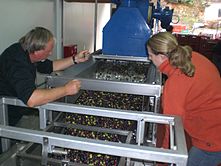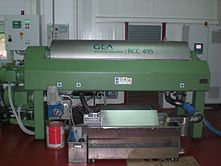Olive Oil
Olive oil (or just oil) is called in Greek the oil derived from the fruit of the olive tree.
Olive oil is a key element of the Mediterranean diet and health food product, due to its content of monounsaturated fat .It is the oil of the fruit of the olive tree. It is extracted by crushing the olives, which must be collected prior to their final maturity, i.e. when they have the green- aubergine color, since the quality of the oil is much better than that of the oil extracted from the fully mature fruit . The olives are picked by hand or by shaking the tree when they are completely mature. Stored in wooden containers or in piles, in well-ventilated areas to prevent fermentation.
Production and processing



The olive oil is produced in mills, with cold or hot pressing olives. In several cases it is filtered with straining ways.
Modern mills are independent industries which have plenty of water for cleaning and processing of olives. The various areas of the mill are well ventilated, dry and have thermal insulation. However, there are some small mills attached to farms, where the olive oil production is made by traditional systems .The farmers call them liarouvia or oil presses.
In the mills the processing begins with the weighing, the separation and the washing of olives. Olives placed in wooden crates carried on elevators in a large basin which is a rise of the mill. From there the olives drop with funnel tubes to the mill. This consists of crushers or millstone. After first crushing, and pressing the first oil is exported and only the olive paste remains. The olive paste is transferred to a second oil-press (pressure rising cylinder), where the second olive oil is extracted. Finally, a third expression is taken place from which the remained pieces of the olive paste is concentrated in basins (core or oil cakes). Then, the core goes to boilers, where it is stirred and heated to 80-90 degrees Celsius.
At this stage using powerful hydraulic presses a new quantity of olive oil is extracted from oil Pomace (kernel). This is determined by the sediment (dregs) with automatic separation into tanks (Libby, ypolinaia) and subsequently at tachystrofous centrifugal olive oil separators. In mills where there are also tanks, the sediment and the olives washing water are concentrated. These, after remaining in the tanks for almost 20 days, pass through a centrifugal separator and give Pomace oils which are suitable for the production of soaps. The liquid wastes (OMW) are dried and used as fertilizers, as animal feeding materials or fuel. In the last case they are concentrated in cubes with tar in a temperature of 70 Celsius. Degrees.
Depending on the type of machinery, the processing system, the quality and the time of the harvest, different secondary products or different Pomace oil can be produced in the mills .The olive oils sold in the markets are distinguished in natural edible and industrial ones. The first type (natural edible one) is divided into green olive oil and first, second or third quality grade olive oils. The average yield of 100 Kg of olives, which varies depending on the quality, year and processing system, is almost 15-25 Kg of olive oil, 35-50 kg of olive cores and 35-50 kg of olive residues.
Olive oil and health
The olive oil contains high levels of monounsaturated fatty acids (MUFA) and abundance of bioactive components. Among those the phenolic compounds are extensively studied. Regarding the benefits of MUFA on human health, the U.S. Food and Drinks Organization licensed quality health claims (health claims), for the first time in 2004, regarding the protection offered by the olive oil monounsaturated fatty acids against the risk of cardiovascular disease. Overall, the benefits of the fatty acids in olive oil were summarized in the first International Conference on Olive Oil and Health, 2005.
However olive oil is more than a rich source of monounsaturated fatty acids. Phenolic constituents have shown anti-inflammatory and chemo-protective properties. The oleocanthal of the olive oil has been found to have a similar effect to anti-inflammatory medication IBUNOPROFENE. Cytotoxicity has not been presented in any of those studies, which have examined the role of the phenolic compounds in olive oil.
The European study EUROLIVE (The effect of olive oil consumption on oxidative damage in European populations) presented in 2006 documented evidence for the protective role of phenolic compounds in olive oil. The experiments of that study conducted in 200 healthy volunteers from all Europe and showed protection against oxidative stress, after daily consumption of 25 ml of olive oil rich in phenolic compounds (virgin olive oil). Specifically it showed increases in levels of HDL (good cholesterol) and reduced lipid markers of oxidative stress after three months consumption of virgin olive oil. Moreover, the same study showed a reduction in markers of oxidation of DNA, in the level of 13% - a rate comparable to the amounts observed after smoking give up.



